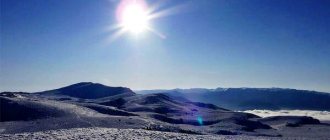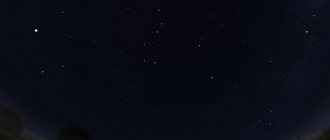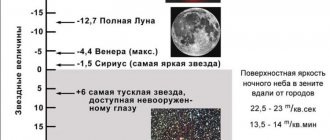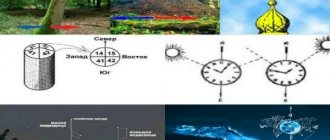- November 4, 2018
- Tips for tourists
- Ivan Lapaev
Sunrise and sunset are natural processes that occur regularly in our Universe. True, to be precise, the Sun does not rise and set, but remains motionless. Contrary to the popular belief of our ancient ancestors, this celestial body does not revolve around our planet, but the Earth, along with seven other planets, revolves around the Sun, simultaneously rotating around its axis, in the direction from west to east.
Knowing which side the Sun rises from can be useful to a tourist as a way to navigate the area and even serve as a replacement for a compass. In addition, there are people who like to admire the sunset. From the article, readers can find out where the Sun sets and rises.
Types of hemispheres and differences between them
Expert opinion
Smirnov Alexander Stanislavovich
Wilderness survival instructor. More than 15 years of teaching experience
There are 4 types of hemispheres - Southern and Northern, Western and Eastern. Briefly describing Western and Eastern, it should be noted that they differ in time zones.
That is, when it is day in the Western Hemisphere, it is night in the Eastern Hemisphere and vice versa. This happens because the Earth rotates around its axis.
At different times of the day, the Earth “exposes” different parts of itself to the Sun.
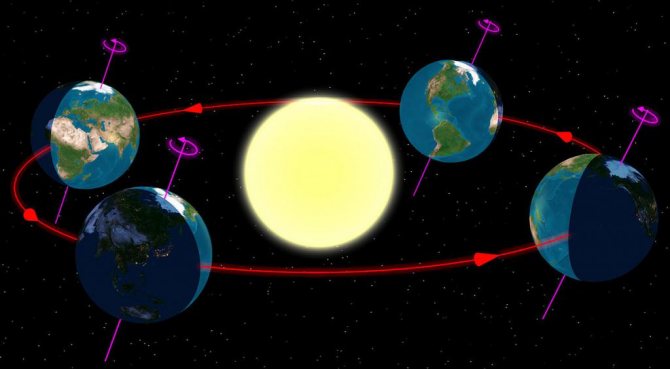
But we are interested in the Northern and Southern Hemispheres. They differ according to the seasons. That is, if it is winter in the North, then it is summer in the South and vice versa. Spring and autumn, respectively, are also swapped. This occurs due to the rotation of the Earth around the Sun and its uneven illumination.
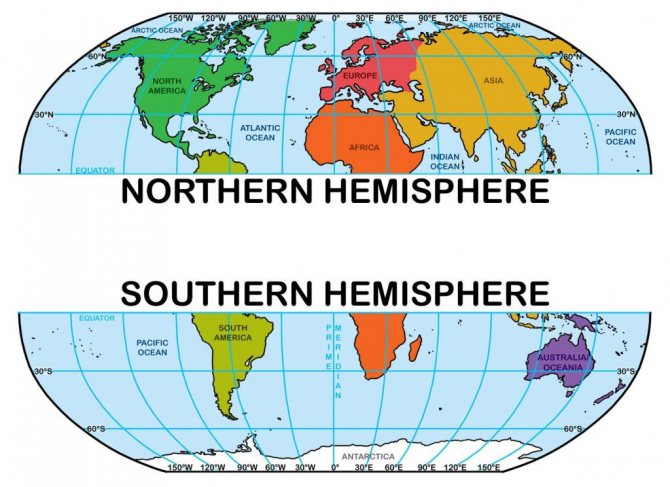
Where does the Sun set and where does it rise?
If we consider the Northern Hemisphere, then in the summer the Sun rises between north and east, and sets between north and west. In winter it rises between the south and the east, and sets between the west and south.
In autumn and spring, the Sun rises between the northeast and southeast, and sets between the northwest and southwest. On the days of the autumn and spring equinox, as already noted, it rises and sets strictly in the east and west, respectively.
In the Southern Hemisphere the opposite is true. This explains the difference between the seasons.
It is necessary to mention that the contrast between night and day is higher the further north the area in question is located in the Northern Hemisphere, and the further south it is in the Southern Hemisphere. That is, if you formulate a certain rule, it will sound like this: the closer the territory is to the pole, the stronger the difference between night and day will appear.
And accordingly, the closer the territory is to the equator, the less pronounced the difference between day and night.
If we look at a specific example, then at the poles the nights last for several months, just like the days. And at the equator there is practically no difference between night and day. Because of this, there is never winter and summer at the equator; there is always the same illumination.
This is interesting: Symbols on the site plan
Sun way
Every morning the gentle sun calls us to awakening and new discoveries in this wonderful world. And in the evening, making its slow move across the sky, it goes beyond the horizon, giving you the opportunity to relax after a busy day of work. Where does this journey begin? Where does the sun set at the end of the journey?
The rise of the main luminary begins in the east. The sun leaves us at the end of the day in the west.
After this, it continues its journey, but on the other side of our amazing planet. And in the morning it rises again in the east.
This is how the picture described appears to us from Earth. Interestingly, ancient people considered this point of view to be incorrect. In this case, where does the sun actually set, and how does it appear again in the sky?
If you do not delve into the details of the worldview of the inhabitants of antiquity, then we can say that they were right. The fact is that our planet is part of the solar system, where the Sun is motionless and located in the center.
Expert opinion
Smirnov Alexander Stanislavovich
Wilderness survival instructor. More than 15 years of teaching experience
The Earth moves around it in its orbit and, in addition to this movement, rotates around its imaginary axis. The planet makes a full revolution in 24 hours, in other words, in a day.
That is why it seems to us that the places where the sun sets and where it returns in the morning are unchanged.
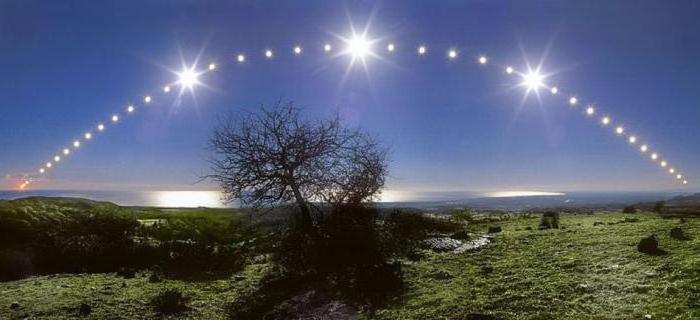
North Pole and other parts of the world
If a person could study the movement of the main luminary from the North Pole, he would see the rotation of the Earth counterclockwise, as well as the place where the sun sets and how it rises. Visually, the movement of the celestial body will appear as a move from east to west. In fact, it will move east, and the Earth will rotate around its axis.
Interestingly, in different parts of the world the sun does not rise at the same time. For example, on the East Coast of the United States this occurs another 3 hours before those areas that are on the Western coast. Accordingly, sunset in different parts of the world occurs at different times.
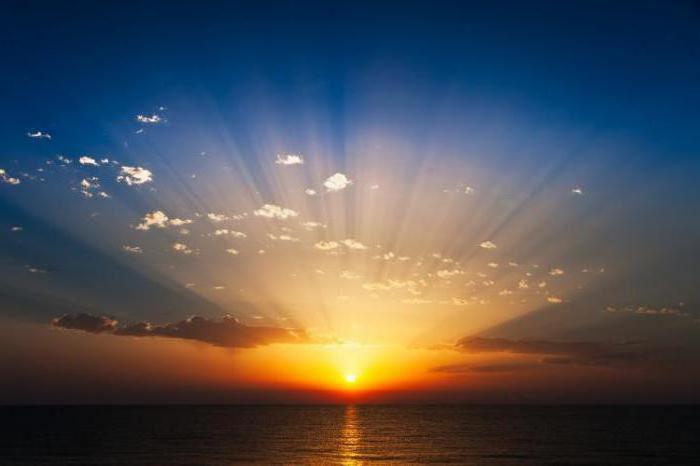
Features of the annual movement of the Sun
Even ancient observers noticed the unevenness of the apparent movement of the celestial sphere of the Sun throughout the year. In autumn and winter the Sun moves faster than in spring and summer.
The Sun moves faster around January 3 (about 1° 1' per day), and slower around July 4 (57' per day). Therefore, spring and summer last 186 days, and autumn and winter - 179 days
The apparent diameter of the solar disk also varies throughout the year. It is greatest (32.5') when the speed of the Sun is greatest, that is, in January, and the smallest (31.5') is in July. This means that the distance to the Sun in winter is less than in summer.
The change in the distance from the Earth to the Sun over the course of a year indicates that the Sun is not at the center of the Earth's orbit. In fact, the Earth's orbit is not a circle, but an ellipse, and the Sun lies at one of its foci. The movement of the Earth in its orbit is not uniform: the closer the Earth is to the Sun, the faster it is.
The point at which the Earth is closest to the Sun is called perihelion . The Earth passes this point on January 3.
The opposite point, where the Earth is farthest from the Sun, is called aphelion . The Earth passes through aphelion on July 4th.
Due to gravitational disturbances, the perihelion and aphelion points are slightly shifted along the Earth's orbit, therefore the dates of the Earth's passage through perihelion and aphelion are only the average dates for our era. The moments of the minimum distance from the Earth to the Sun in different years occur on the days from January 2 to 5, and the moments of the greatest distance – from July 1 to 5.
Orientation: how to determine the cardinal directions without a compass on the ground?
If you have a wristwatch with hands (not electronic), then in the “horizontal” position you need to turn it clockwise towards the sun. Drawing an imaginary bisector between the number 12 and the direction to the celestial body, we obtain a “north-south” line. It is also interesting that until noon, the south is to the right of the sun.
Understanding how to determine the cardinal directions without a compass, a person will be able to navigate anywhere and go in the right direction. This knowledge is very important, especially for tourists, forestry workers, hunters, sailors and people engaged in other activities.
The method described above can give relatively accurate results in northern latitudes. In temperate climates it works only partly (especially in winter). In the southern regions, the summer sun is high, so errors may occur. In addition, you need to take into account the transition to and from daylight saving time (as this affects the definition of noon).
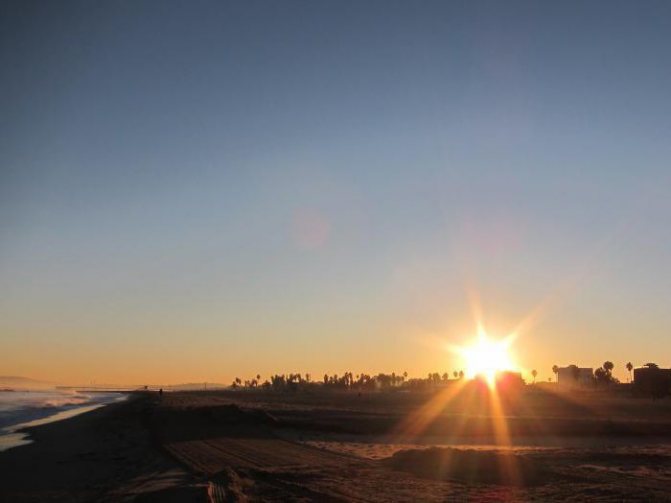
It is also important to remember where the sun rises and where it sets in mid-latitudes. In these places, the main luminary rises in the summer in the northeast, and sets in the northwest.
3rd - in the southeast and southwest, respectively. Only 2 times a year the sun rises exactly in the east and sets exactly in the west.
These are the days of the equinoxes - March 21 and September 23.
Orientation by compass
If you have to navigate in the forest, the most reliable way is to use a compass. In order for its readings to be accurate, it must be kept away from electronic devices, metal objects and magnets. Before navigating the terrain, you need to set the compass in a horizontal position and remove the stopper from the arrow. After some time, the arrow will take a “south-north” position, with the red end indicating the north direction. If you stand facing this direction, then on the right there will be east, on the left - west. In order not to go astray, you need to check the correctness of the chosen direction of your movement more often.
Shadow and navigation
There is another way to navigate by shadow. In unfamiliar places, when this need arises, you need to take into account different heavenly bodies. At night it can be the polar star, and during the day it can be the sun.
Understanding which side the sun sets from, you can determine other directions of the world and choose the right direction of travel. For example, in northern latitudes, when the time of summer nights comes, the setting sun is close to the horizon. Therefore, the sky on the north side is lighter than on the south.
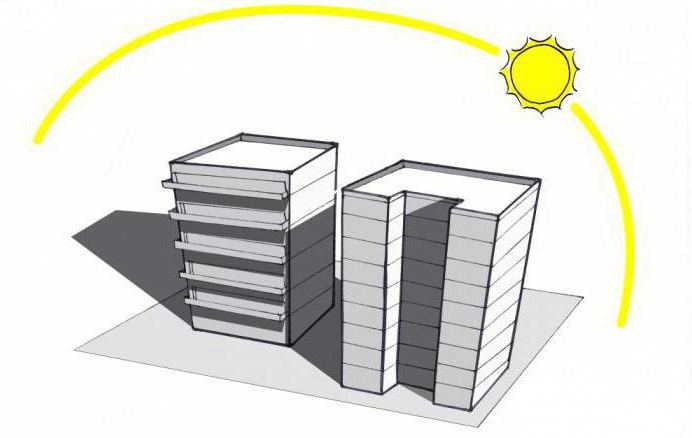
It is known that the highest solar position can be determined by the shortest shadow. This corresponds to noon.
The direction of such a shadow points to the north. It’s the same with the moon: if it’s full and occupies the highest position above the horizon, it means it’s in the south.
This is the time when there is enough light to clearly distinguish shadows. Likewise, during a full moon, the shadow is the shortest.
This is interesting: How to knit a double fishing clinch knot: diagram
It's midnight. The direction of the shadow will point to the north.
Every person knows that the sun is a star around which the Earth and other planets revolve. Probably everyone has heard that this celestial body appears in the East and disappears in the West. But not everyone knows where the sun sets and why exactly there. Further in the article we will try to consider the question of the place of appearance and disappearance of the celestial body.
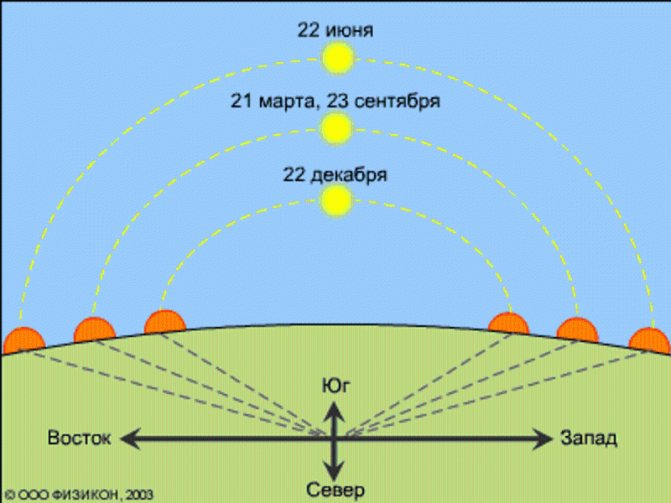
How to navigate by the moon and the clock
Let's look at how to navigate by the moon, a brief summary. Sometimes at night, cloudy skies may prevent the polar star from being detected, but the moon can be seen. Let's determine the direction of the world using a clock and the moon. Again, we look for the moon, weather permitting. There are 8 phases of the moon, but we will talk about 4 of them - new moon, 1st quarter, full moon and 3rd quarter. On a full moon, consider yourself lucky.
We must remember: the full moon at midnight indicates the direction to the south, at 6 am to the west and at 18 o'clock to the east.
And if there is no moon, then it is a new moon and you are out of luck. For subsequent data, learn to distinguish between the first and last phases of the moon - growing and aging. If the moon looks like C, it is aging. If, with the addition of the stick on the left, the result is P - growing. Let's look at the phase of the waxing moon, at 17 o'clock it will point to the south, at midnight to the west, in the morning it will not be visible. The last phase is the aging moon: at 6 am in the south, at midnight in the east, not visible in the evening. And all these numbers relate to winter time. By observing the moon in the southern hemisphere, data will be obtained.
We recommend reading:
DrimSim - tourist SIM card for travelers
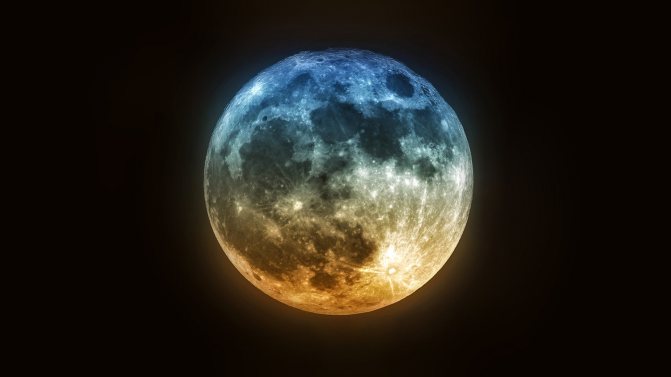
Landmark by the moon
It was discussed how to navigate by the moon at night. At night, find shelter and wait until the morning, but if there is such a need to move somewhere at night, use these methods. When the polar star is not visible. The polar star indicates the direction of north. To summarize, this method is approximate and will not always provide accurate data. With experience you will become more accurate.
It is important to remember that a magnetic compass will indicate the exact direction as it points to the magnetic pole. Without knowing the magnetic declination, the result will be inaccurate. But, knowing these methods, you can navigate in the desert without a compass.
How the sun moves
After the celestial body appears on the horizon, its movement continues continuously. Throughout the day you can watch the sun move across the sky. In fact, it is not the sun that moves, but the globe making a revolution around the star. Moreover, the duration of the entire process is 24 hours.
We can easily explain why a room in an apartment with windows facing south is always significantly lighter compared to similar rooms with access to other sides of the world. The thing is that during the day the sun moves along the projection of the southern horizon and ultimately reaches its peak point.
This whole process in scientific terminology is called the culmination of a celestial body.
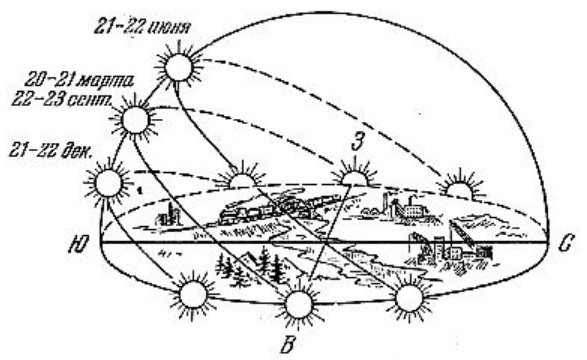
Orientation by the sun and clock
To determine the direction of the cardinal points, you don’t have to use a watch; you can do it roughly “by eye.” But the result with a watch will be much more accurate. Orientation by the sun and the clock is based on the fact that the location of the sun changes along a certain trajectory during the day, and, knowing at what time where it should be, we can determine the cardinal directions.

Movement of the sunset point
The sun sets in the West only twice a year. These dates are considered to be March 20 and 21, as well as September 22 and 23. They are also called equinox days. Just then, the sun sets exactly in the West.
The length of the day is twelve hours. Perhaps these dates are the only ones when the sun actually sets in the Western part of the horizon.
After the spring equinox passes, the sun begins to move higher in the sky, which is why the days begin to get longer. Accordingly, the sunset and sunrise points are moving closer to the north every day. This entire process lasts until June 21. The solstice occurs on this day. It is then that the point of entry is most shifted to the north, and the length of the day is longer.
In cities located above the Arctic Circle, the sunset and sunrise points merge into one, which ensures that the celestial body does not leave the horizon and the polar day begins.
After June 22, the sunset point begins to gradually shift to the western and eastern parts. The same thing happens with the sunrise point.
Due to this, the length of the day is shortened. After September 23, the point where the sun rises begins to move closer to the point of its sunset, this happens south of the horizon.
All this lasts until the winter solstice. It was then that the celestial body appears and disappears to the south of all previous days, and that is precisely why this night is the longest during this period.

An interesting fact is that it is on these days that the polar day gives way to polar night. The celestial body does not appear beyond the horizon.
Expert opinion
Smirnov Alexander Stanislavovich
Wilderness survival instructor. More than 15 years of teaching experience
This phenomenon is connected, first of all, with the fact that the points where the Sun sets and where it rises converge in the south. As the winter solstice passes, things gradually begin to change.
The sunset and sunrise points begin to move in the opposite direction, because of this you can observe a lengthening of the daylight hours.
§ 52. Apparent annual motion of the Sun and its explanation
Home / Publications / Literature / Bookshelf / G.G. Ermolaev, L.P. Andronov, E.S. Zoteev, Yu.P. Kirin, L.F. Cherniev. Maritime navigationObserving the daily movement of the Sun throughout the year, one can easily notice a number of features in its movement that differ from the daily movement of stars. The most typical of them are the following.
1. The place of sunrise and sunset, and therefore its azimuth, changes from day to day. Starting from March 21 (when the Sun rises at the point of the east and sets at the point of the west) to September 23, the sun rises in the northeastern quarter, and sunset in the northwestern quarter. At the beginning of this time, the sunrise and sunset points move north and then in the opposite direction. On September 23, just like on March 21, the Sun rises at the east point and sets at the west point. Starting from September 23 to March 21, a similar phenomenon will repeat in the southeast and southwest quarters. The movement of sunrise and sunset points has a one-year period.
The stars always rise and set at the same points on the horizon.
2. The meridional altitude of the Sun changes every day. For example, in Odessa (average = 46°.5 N) on June 22 it will be greatest and equal to 67°, then it will begin to decrease and on December 22 it will reach its lowest value of 20°. After December 22, the meridional altitude of the Sun will begin to increase. This is also a one-year phenomenon. The meridional altitude of stars is always constant. 3. The duration of time between the culminations of any star and the Sun is constantly changing, while the duration of time between two culminations of the same stars remains constant. So, at midnight we see those constellations culminating that are currently located on the opposite side of the sphere from the Sun. Then some constellations give way to others, and over the course of a year at midnight all the constellations will culminate in turn.
4. The length of the day (or night) is not constant throughout the year. This is especially noticeable if you compare the length of summer and winter days in high latitudes, for example in Leningrad. This happens because the time the Sun is above the horizon varies throughout the year. The stars are always above the horizon for the same amount of time.
Thus, the Sun, in addition to the daily movement performed jointly with the stars, also has a visible movement around the sphere with an annual period. This movement is called the apparent annual movement of the Sun across the celestial sphere.
We will get the most clear idea of this movement of the Sun if we determine its equatorial coordinates every day - right ascension a and declination b. Then, using the found values of the coordinates, we plot the points on the auxiliary celestial sphere and connect them with a smooth curve. As a result, we obtain a large circle on the sphere, which will indicate the path of the visible annual movement of the Sun. The circle on the celestial sphere along which the Sun moves is called the ecliptic. The plane of the ecliptic is inclined to the plane of the equator at a constant angle g = =23°27′, which is called the angle of inclination of the ecliptic to the equator
(Fig. 82).
Rice. 82.
The apparent annual movement of the Sun along the ecliptic occurs in the direction opposite to the rotation of the celestial sphere, that is, from west to east.
The ecliptic intersects the celestial equator at two points, which are called the equinox points. The point at which the Sun passes from the southern hemisphere to the northern, and therefore changes the name of the declination from southern to northern (i.e. from bS to bN), is called the vernal equinox
and is designated by the Y icon. This icon denotes the constellation Aries, in which when -this point was located. Therefore, it is sometimes called the Aries point. Currently, point T is located in the constellation Pisces.
The opposite point at which the Sun passes from the northern hemisphere to the southern and changes the name of its declination from bN to bS is called the autumn equinox point.
It is designated by the symbol of the constellation Libra O, in which it was once located. Currently, the autumn equinox point is in the constellation Virgo.
Point L is called the summer point,
and point L' is the
winter solstice point.
Let's follow the apparent movement of the Sun along the ecliptic throughout the year.
The Sun arrives at the vernal equinox on March 21st. The right ascension a and declination b of the Sun are zero. Throughout the globe, the Sun rises at point Ost and sets at point W, and day is equal to night. Starting March 21, the Sun moves along the ecliptic towards the summer solstice point. The right ascension and declination of the Sun are continuously increasing. It is astronomical spring in the northern hemisphere, and autumn in the southern hemisphere.
On June 22, approximately 3 months later, the Sun comes to the summer solstice point L. The direct ascension of the Sun is a = 90°, a declination b = 23°27'N. In the northern hemisphere, astronomical summer begins (the longest days and shortest nights), and in the southern hemisphere, winter begins (the longest nights and shortest days). As the Sun moves further, its northern declination begins to decrease, but its right ascension continues to increase.
About three more months later, on September 23, the Sun comes to the point of the autumnal equinox Q. The direct ascension of the Sun is a=180°, declination b=0°. Since b = 0 ° (like March 21), then for all points on the earth’s surface the Sun rises at point Ost and sets at point W. Day will be equal to night. The name of the declination of the Sun changes from northern 8n to southern - bS. It is astronomical autumn in the northern hemisphere, and spring in the southern hemisphere. With further movement of the Sun along the ecliptic to the winter solstice point U, declination 6 and right ascension aO increase.
On December 22, the Sun comes to the winter solstice point L'. Right ascension a=270° and declination b=23°27'S. Astronomical winter begins in the northern hemisphere, and summer begins in the southern hemisphere.
After December 22, the Sun moves to point T. The name of its declination remains southern, but decreases, and its right ascension increases. Approximately 3 months later, on March 21, the Sun, having completed a full revolution along the ecliptic, returns to the point of Aries.
Changes in the right ascension and declination of the Sun do not remain constant throughout the year. For approximate calculations, the daily change in the right ascension of the Sun is taken equal to 1°. The change in declination per day is taken to be 0°.4 for one month before the equinox and one month after, and the change is 0°.1 for one month before the solstices and one month after the solstices; the rest of the time, the change in solar declination is taken to be 0°.3.
The peculiarity of changes in the right ascension of the Sun plays an important role when choosing the basic units for measuring time.
The vernal equinox point moves along the ecliptic towards the annual movement of the Sun. Its annual movement is 50″.27 or rounded 50″.3 (for 1950). Consequently, the Sun does not reach its original location relative to the fixed stars by 50″.3. For the Sun to travel the indicated path, it will take 20mm 24c. For this reason spring
It occurs before the Sun completes its visible annual motion, a full circle of 360° relative to the fixed stars. The shift in the moment of the onset of spring was discovered by Hipparchus in the 2nd century. BC e. from observations of stars that he made on the island of Rhodes. He called this phenomenon the anticipation of the equinoxes, or precession.
The phenomenon of moving the vernal equinox point caused the need to introduce the concepts of tropical and sidereal years. The tropical year is the period of time during which the Sun makes a full revolution across the celestial sphere relative to the vernal equinox point T. “The duration of the tropical year is 365.2422 days. The tropical year is consistent with natural phenomena and precisely contains the full cycle of the seasons of the year: spring, summer, autumn and winter.
A sidereal year is the period of time during which the Sun makes a complete revolution across the celestial sphere relative to the stars. The length of a sidereal year is 365.2561 days. The sidereal year is longer than the tropical year.
In its apparent annual movement across the celestial sphere, the Sun passes among various stars located along the ecliptic. Even in ancient times, these stars were divided into 12 constellations, most of which were given the names of animals. The strip of sky along the ecliptic formed by these constellations was called the Zodiac (circle of animals), and the constellations were called zodiacal.
According to the seasons of the year, the Sun passes through the following constellations:
The combined movement of the Sun—annual along the ecliptic and daily due to the rotation of the celestial sphere—creates the general movement of the Sun along a spiral line. The extreme parallels of this line are located on both sides of the equator at distances of = 23°.5.
On June 22, when the Sun describes the extreme diurnal parallel in the northern celestial hemisphere, it is in the constellation Gemini. In the distant past, the Sun was in the constellation Cancer. On December 22, the Sun is in the constellation Sagittarius, and in the past it was in the constellation Capricorn. Therefore, the northernmost celestial parallel was called the Tropic of Cancer, and the southern one was called the Tropic of Capricorn. The corresponding terrestrial parallels with latitudes cp = bemach = 23°27′ in the northern hemisphere were called the Tropic of Cancer, or the northern tropic, and in the southern hemisphere, the Tropic of Capricorn, or the southern tropic.
The joint movement of the Sun, which occurs along the ecliptic with the simultaneous rotation of the celestial sphere, has a number of features: the length of the daily parallel above and below the horizon changes (and therefore the duration of day and night), the meridional heights of the Sun, the points of sunrise and sunset, etc. etc. All these phenomena depend on the relationship between the geographic latitude of a place and the declination of the Sun. Therefore, for an observer located at different latitudes, they will be different.
Let's consider these phenomena at some latitudes:
1. The observer is at the equator, cp = 0°. The axis of the world lies in the plane of the true horizon. The celestial equator coincides with the first vertical. The diurnal parallels of the Sun are parallel to the first vertical, therefore the Sun in its daily movement never crosses the first vertical. The sun rises and sets daily. Day is always equal to night. The Sun is at its zenith twice a year - on March 21 and September 23.
Rice. 83.
2. The observer is at latitude φ
3. The observer is at latitude 23°27′
4. The observer is at latitude φ > 66°33'N or S (Fig. 83). Polar belt. Parallels f = 66°33'N or S are called polar circles. In the polar zone, polar days and nights can be observed, that is, when the Sun is above the horizon for more than a day or below the horizon for more than a day. The longer the polar days and nights, the greater the latitude. The sun rises and sets only on those days when its declination is less than 90°-φ.
5. The observer is at the pole φ=90°N or S. The axis of the world coincides with the plumb line and, therefore, the equator with the plane of the true horizon. The observer's meridian position will be uncertain, so parts of the world are missing. During the day, the Sun moves parallel to the horizon.
On the days of the equinoxes, polar sunrises or sunsets occur. On the days of the solstices, the height of the Sun reaches its greatest values. The altitude of the Sun is always equal to its declination. The polar day and polar night last for 6 months.
Thus, due to various astronomical phenomena caused by the combined daily and annual movement of the Sun at different latitudes (passage through the zenith, polar day and night phenomena) and the climatic features caused by these phenomena, the earth's surface is divided into tropical, temperate and polar zones.
Tropical zone
is the part of the earth's surface (between latitudes φ=23°27'N and 23°27'S) in which the Sun rises and sets every day and is at its zenith twice during the year. The tropical zone occupies 40% of the entire earth's surface.
Temperate zone
called the part of the earth's surface in which the Sun rises and sets every day, but is never at its zenith. There are two temperate zones. In the northern hemisphere, between latitudes φ = 23°27'N and φ = 66°33'N, and in the southern hemisphere - between latitudes φ = 23°27'S and φ = 66°33'S. Temperate zones occupy 50% of the earth's surface.
Polar belt
called the part of the earth's surface in which polar days and nights are observed. There are two polar zones. The northern polar belt extends from latitude φ = 66°33'N to the north pole, and the southern one - from φ = 66°33'S to the south pole. They occupy 10% of the earth's surface.
For the first time, the correct explanation of the visible annual movement of the Sun across the celestial sphere was given by Nicolaus Copernicus (1473-1543). He showed that the annual movement of the Sun across the celestial sphere is not its actual movement, but only an apparent one, reflecting the annual movement of the Earth around the Sun. The Copernican world system was called heliocentric. According to this system, at the center of the solar system is the Sun, around which the planets move, including our Earth.
The Earth simultaneously participates in two movements: it rotates around its axis and moves in an ellipse around the Sun. The rotation of the Earth around its axis causes the cycle of day and night. Its movement around the Sun causes the change of seasons. The combined rotation of the Earth around its axis and the movement around the Sun causes the visible movement of the Sun across the celestial sphere.
To explain the apparent annual movement of the Sun across the celestial sphere, we will use Fig. 84. The Sun S is located in the center, around which the Earth moves counterclockwise. The earth's axis remains unchanged in space and makes an angle of 66°33′ with the ecliptic plane. Therefore, the equatorial plane is inclined to the ecliptic plane at an angle e=23°27′. Next comes the celestial sphere with the ecliptic and the signs of the Zodiac constellations marked on it in their modern location.
The Earth enters position I on March 21. When viewed from the Earth, the Sun is projected onto the celestial sphere at point T, currently located in the constellation Pisces. The declination of the Sun is 0°. An observer located at the Earth's equator sees the Sun at its zenith at noon. All earthly parallels are half illuminated, so at all points on the earth's surface day is equal to night. Astronomical spring begins in the northern hemisphere, and autumn begins in the southern hemisphere.
Rice. 84.
The Earth enters position II on June 22. Declination of the Sun b=23°,5N. When viewed from Earth, the Sun is projected into the constellation Gemini. For an observer located at latitude φ=23°.5N, (The sun passes through the zenith at noon. Most of the daily parallels are illuminated in the northern hemisphere and a smaller part in the southern hemisphere. The northern polar zone is illuminated and the southern one is not illuminated. In the northern, the polar day lasts, and in the southern - polar night.In the northern hemisphere of the Earth, the rays of the Sun fall almost vertically, and in the southern - at an angle, so astronomical summer begins in the northern hemisphere, and winter in the southern.
The Earth enters position III on September 23. The declination of the Sun is bo = 0 ° and it is projected at the point of Libra, which is now located in the constellation Virgo. An observer located at the equator sees the Sun at its zenith at noon. All earthly parallels are half illuminated by the Sun, so at all points on the Earth day is equal to night. Astronomical autumn begins in the northern hemisphere, and spring begins in the southern hemisphere.
On December 22, the Earth comes to position IV. The Sun is projected into the constellation Sagittarius. Declination of the Sun 6=23°.5S. In the southern hemisphere, more of the diurnal parallels are illuminated than in the northern hemisphere, so in the southern hemisphere the day is longer than the night, and in the northern hemisphere it is vice versa. The sun's rays fall almost vertically into the southern hemisphere, and at an angle into the northern hemisphere. Therefore, astronomical summer begins in the southern hemisphere, and winter in the northern hemisphere. The sun illuminates the southern polar zone and does not illuminate the northern one. The southern polar zone experiences polar day, while the northern zone experiences night.
Corresponding explanations can be given for other intermediate positions of the Earth.
Forward Contents Back
Features of daylight hours in the southern hemisphere
As a rule, in the southern hemisphere of the globe everything happens the other way around. At the moment when the northern hemisphere experiences a long day of the year, the opposite one experiences short daylight hours.
This contrast of phenomena is accompanied in everything. When we experience the autumn equinox, it is the spring equinox in the southern hemisphere.
The culmination of the sun also occurs at the opposite point: in the north. But, just like here, the sun sets directly in the western part of the sky.

Video

If our planet did not revolve around the Sun and was absolutely flat, the celestial body would always be at the zenith and would not move anywhere - there would be no sunset, no dawn, no life. Fortunately, we have the opportunity to watch the sun rise and set - and therefore life on planet Earth continues.
This is interesting: Hunting for red deer: secrets of a professional
Celestial equator and ecliptic plane
To explain the movement of the Sun more logically and in detail, it is necessary to consider the processes occurring at the celestial equator. The ecliptic intersects with it in two zones. Their official names are equinox points. Our star is in them in March (21) and September (23). It is on these days that day and night are equal on planet Earth.
Ecliptic points that are 90 degrees from the equinoxes are called solstices. It is in them that the star is in the highest and lowest position in relation to the equator of the sky. In the first case, where the Sun is located high, we are talking about the summer solstice, which falls on June 22. In the second, where the Sun is low - about winter (December 22).
Features of the occurrence of dawn and dusk
The Earth tirelessly moves around the Sun and its axis, and once a day (with the exception of polar latitudes) the solar disk appears and disappears beyond the horizon, indicating the beginning and end of daylight hours. Therefore, in astronomy, sunrise and sunset are the times when the top point of the solar disk appears or disappears above the horizon.
In turn, the period before sunrise or sunset is called twilight: the solar disk is located close to the horizon, and therefore some of the rays, entering the upper layers of the atmosphere, are reflected from it onto the earth's surface. The duration of twilight before sunrise or sunset directly depends on latitude: at the poles they last from 2 to 3 weeks, in the polar zones - several hours, in temperate latitudes - about two hours.
But at the equator, the time before sunrise is from 20 to 25 minutes.

During sunrise and sunset, a certain optical effect is created when the sun's rays illuminate the earth's surface and sky, coloring them in multi-colored tones. Before sunrise, at dawn, the colors have more delicate shades, while sunset illuminates the planet with rays of rich red, burgundy, yellow, orange and very rarely green.
The sunset has such an intensity of colors due to the fact that during the day the earth's surface warms up, humidity decreases, the speed of air flows increases, and dust rises into the air. The difference in color between sunrise and sunset largely depends on the area where a person is located and observes these amazing natural phenomena.
